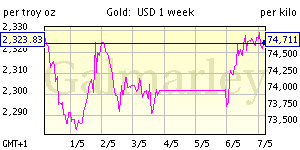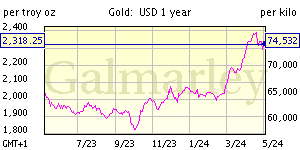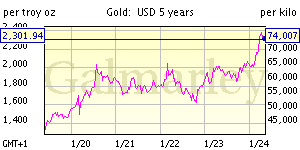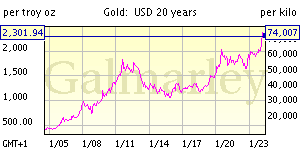Gold Is the Default Currency
In almost four decades of fiat currencies, the International Monetary Fund (IMF) has calculated global dollar reserves at some 60 percent of America's GDP. Because of their reserve currency status, the US government has been able to create dollars at will to meet their obligations. And to pay for those obligations in the next decade, global reserves are expected to increase to twice America's current GDP. Therein lies the dilemma for China and others, there is insufficient backing and the Treasury liabilities will only grow. In contrast, the total of all gold ever mined is about 170,000 metric tons. The price of gold would be equivalent to about $5,000 an ounce today if the dollar liabilities were scaled to the gold supply. Reserve currency status is not a birthright. Once trust disappears, it can vanish quickly.
Gold is very different from paper money. Gold's move to fresh highs reflects that it has become the default currency in a world of devalued currencies. Needed in this struggle is a set of rules to establish a new global financial order and a currency that nations can trust. The world is full of sick economies and sick currencies. Gold is a cure, painful but a cure.
Needed then is a return to using gold as an anchor for currency values. Needed is monetary reform. Needed are fresh ideas. We envisage a Bretton Woods II system where currencies would be linked to the value of gold rather than a fixed paper dollar system. Gold is an alternative money asset today and World Bank's President Zoellick suggestion to use gold in a basket of multiple reserve currencies was not a call to return to a gold standard but an acknowledgement of its role as a time-tested monetary asset. After all, gold is the only commodity held by central banks.
The price of gold has increased primarily due to the loss of purchasing power of currencies, particularly the dollar. The supply of currencies seems unlimited, the supply of gold is not. Measured against a broad basket of commodities, gold is higher and rising much more quickly against all currencies. Gold's move to fresh highs is signalling the fundamental disequilibrium in currency markets and the world economies -sort of like the canaries in the coal mine. As long as the dollar is debased, gold's bull run will go higher. Gold's rise is a reflection of its role as a barometer of investor anxiety. The increasing uncertainty surrounding global financial markets is currently driving the price of gold, yet in inflation adjusted terms, it remains far below its previous peak, equivalent to about $2,300 today. The canaries are chirping.
![[Most Recent Quotes from www.kitco.com]](http://www.kitconet.com/images/quotes_7a.gif)






